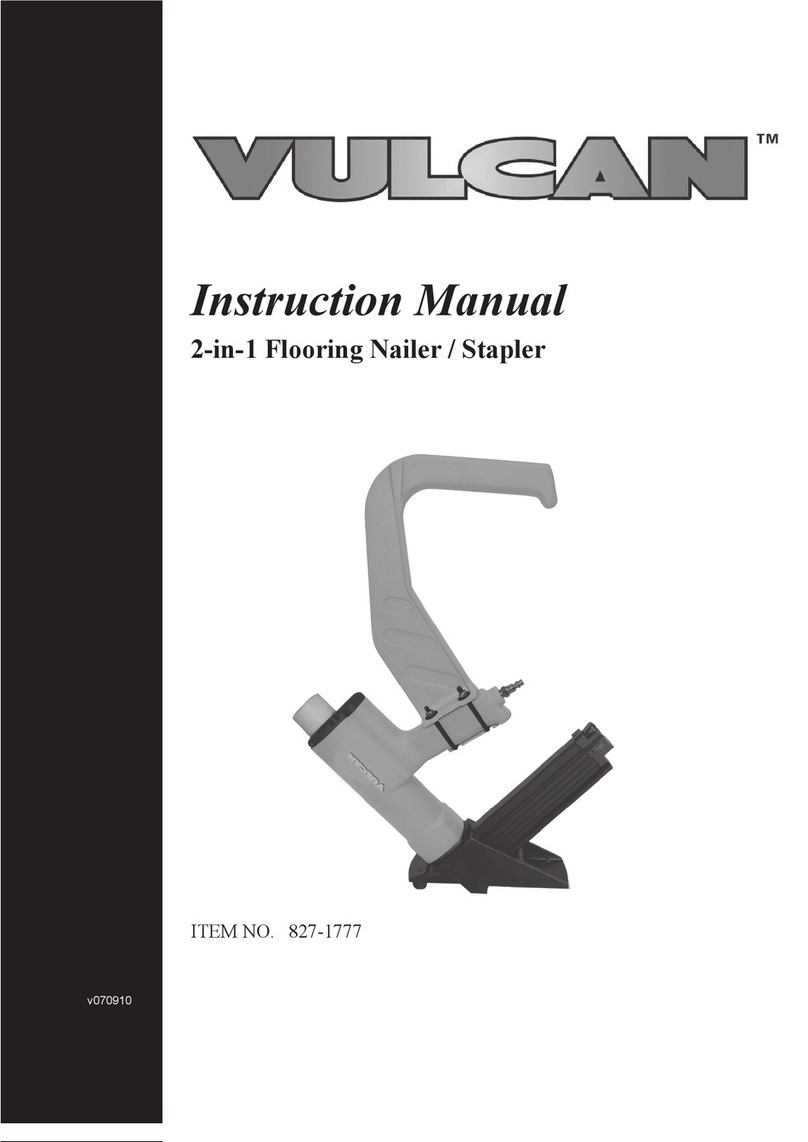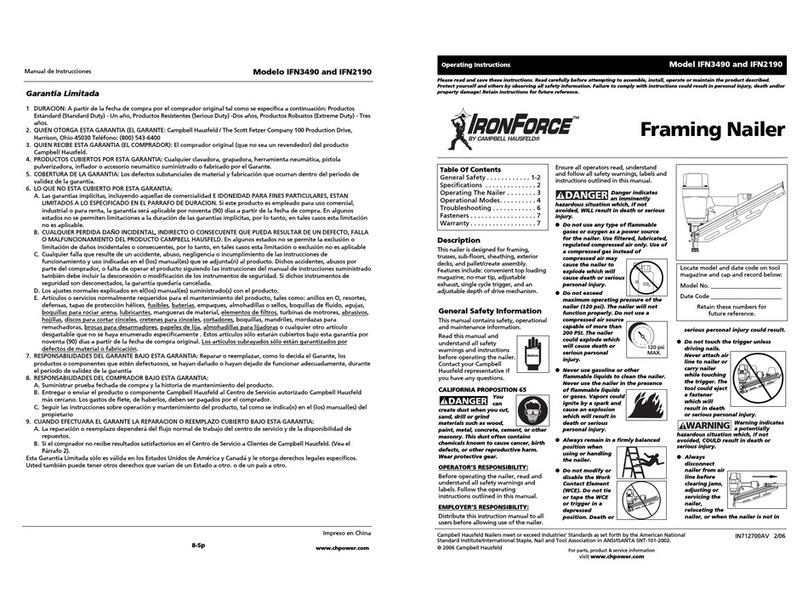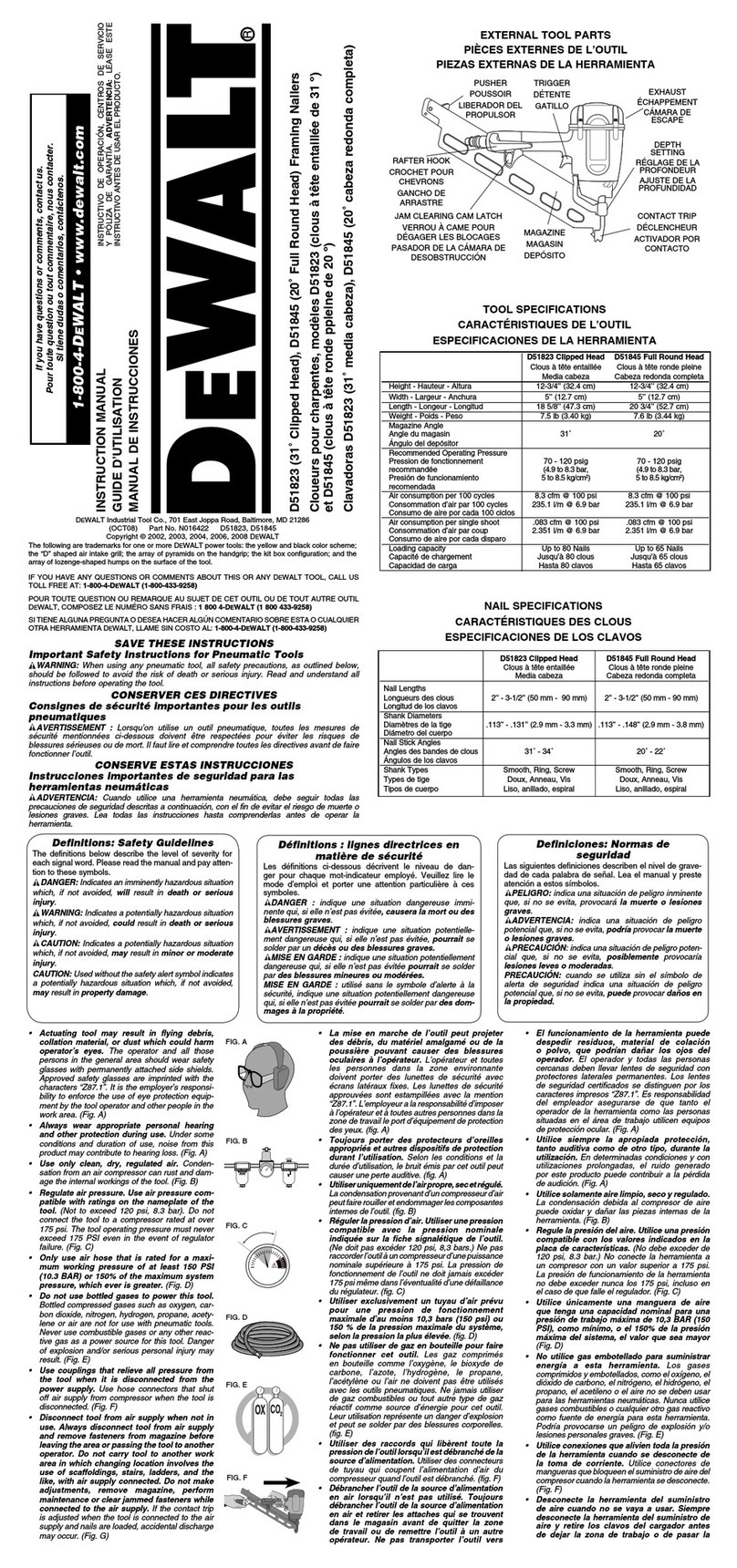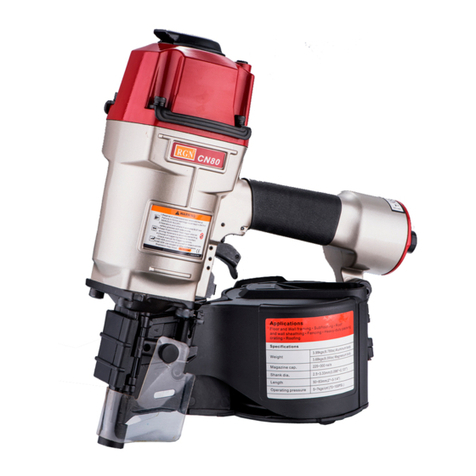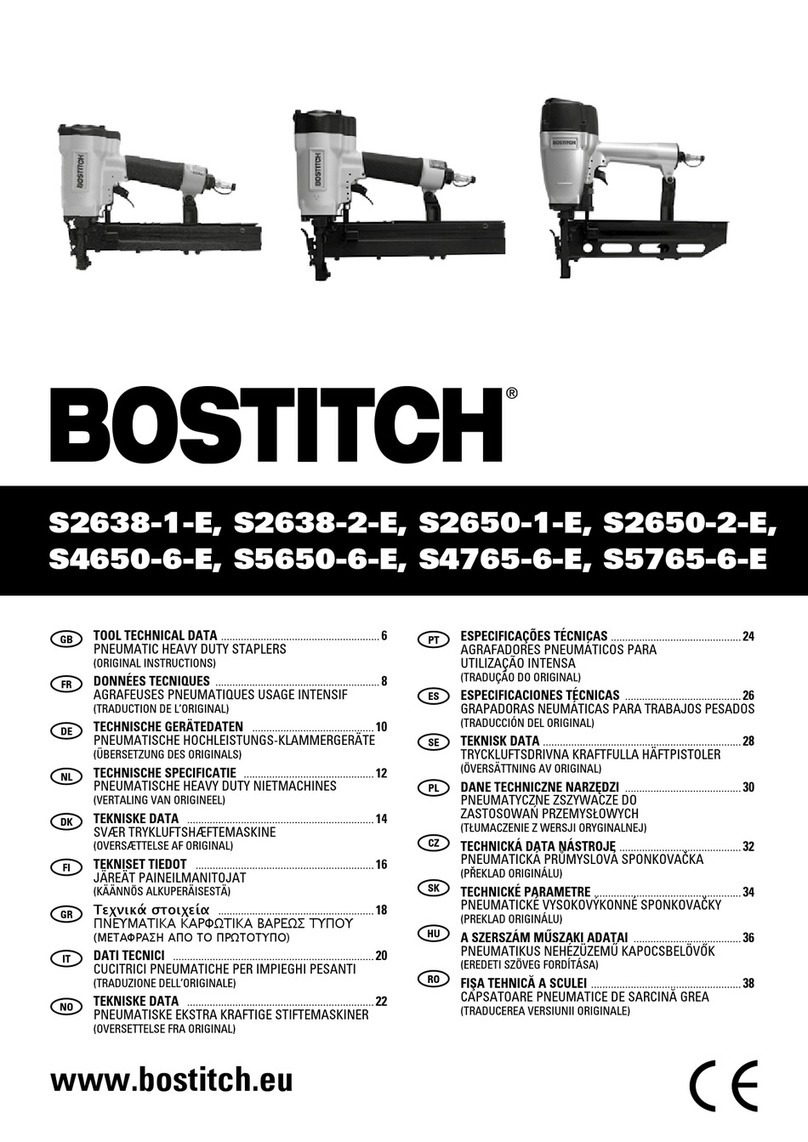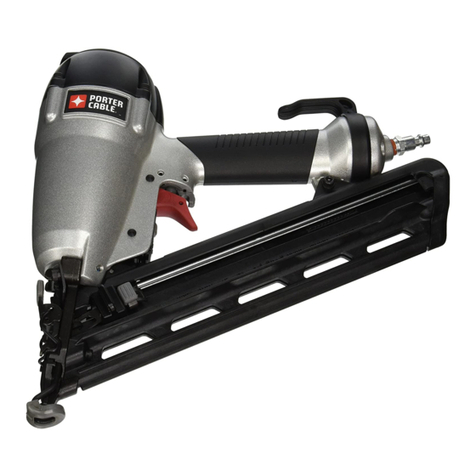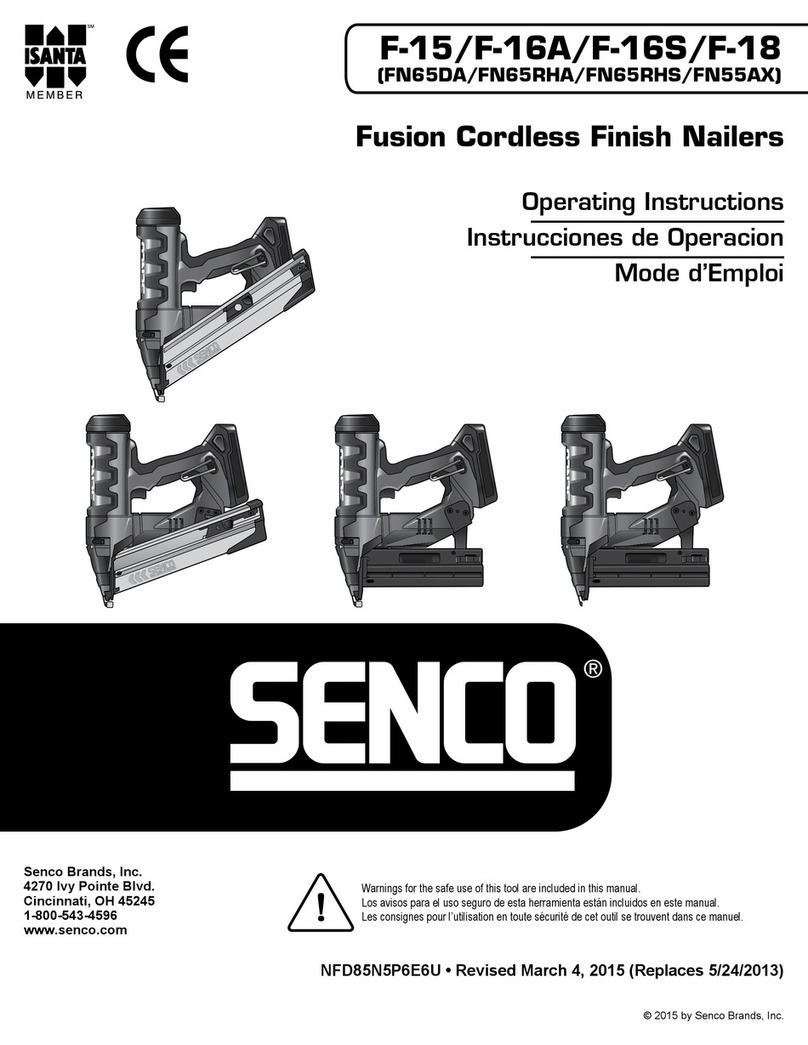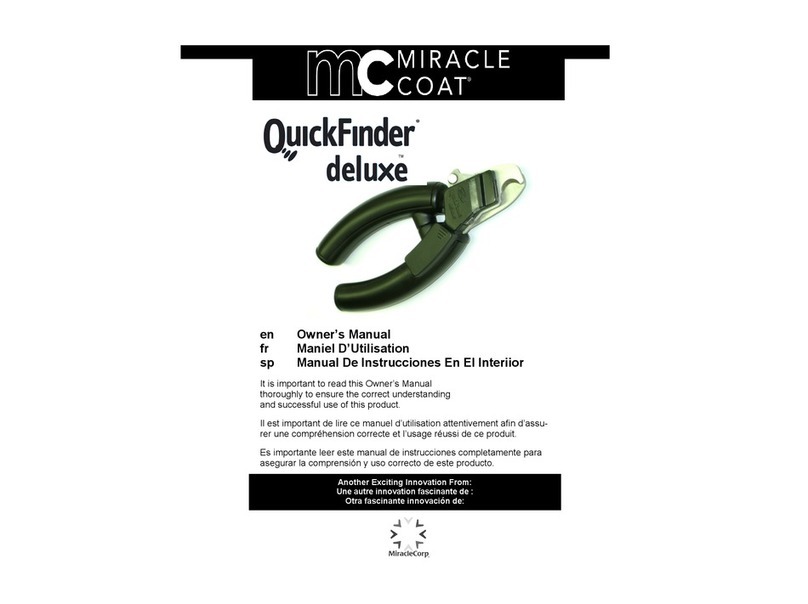Vulcan-Hart 404-7791 User manual

Instruction Manual
Manual de instrucciones
ITEM NO.
ARTÍCULO No.
Combination Brad Nailer / Narrow Crown Stapler
404-7791
v070910

2
THANK YOU for your purchase of this Vulcan Air Tool. With proper care and
use you can expect your purchase to provide years of trouble free service!
SHOULD YOU HAVE A QUESTION OR A PROBLEM WITH YOUR
VULCAN TOOL, PLEASE CALL OUR CUSTOMER SERVICE
DEPARTMENT TOLL FREE AT:
1-800-482-0131
Please have the tool, model number and instruction manual at hand before calling.
ONE YEAR LIMITED CONSUMER WARRANTY
If you have a question or should you have a problem with any Vulcan Air Tool, call
the Vulcan Customer Service line at 1-800-482-0131.
This product is warranted to be free from defects to material and workmanship
for a period of ONE YEAR from date of purchase. If defective the product will be
repaired or replaced. Call the Vulcan Power Tool customer service line at 1-800-
482-0131 and a customer representative will attempt to help resolve any issue. If
directed by a representative, return the product along with proof of purchase to
your dealer. Normal wear, damage due to abuse or mishandling or unauthorized
repair is not covered. This warranty does not apply to accessories. This warranty
gives you specic legal rights that vary from state to state.
This tool is intended for consumer use and is not a commercial tool. In the event
the tool is used commercially, the warranty should be for a period of 30 days.
VULCAN AIR TOOLS ARE MADE EXCLUSIVELY FOR:
Memphis, TN 38101

3
SAFETY RULES FOR ALL TOOLS
Read and understand all instructions. Failure to follow all instructions listed
below may result in serious personal injury.
SAVE THESE INSTRUCTIONS
WARNING
!
Work Area
Keep work area clean and well lit. Cluttered
benches and dark areas invite accidents.
Keep by-standers, children, and visitors away
while using your tool. All children should be kept
away from the work area. Don’t let them handle
machines, tools or extension cords. Visitors can
be a distraction and are difcult to protect from
injury. Distractions can cause you to lose control.
Personal Safety
Stay alert. Watch what you are doing & use
common sense. Keep hands and body away from
the path of any potential red fastener. Do not
operate any tool when you are tired, under the
inuence of drugs, alcohol, or medication. A
moment of inattention while operating this tool
may result in serious injury.
Dress properly. Do not wear loose clothing
or jewelry; they can be caught in moving parts.
Protective, non-electrically conductive gloves
and non-skid footwear are recommended when
working. Wear protective hair covering to contain
long hair and keep it from harm. Keep hands dry,
clean and free from oil and grease.
Safety glasses To prevent eye injuries, the tool
operator and all persons in the work area must
wear ANSI Z87.1 approved safety glasses with
permanently attached, rigid side shields.
Hearing protection. Wear ear protection to
safeguard against possible hearing loss.
Guard against electric shock. Prevent body
contact with grounded surfaces: pipes, radiators,
ranges, and refrigerator enclosures. Before
driving fasteners into walls, oors, or wherever
“live” electrical wires may be encountered, try to
ascertain whether there is a danger of shock.
Do not overreach. Keep proper footing and
balance at all times. Do not reach over or across
machines which are running.
Employers must enforce compliance with the
safety warnings and all other instructions
in this manual. Keep it available for use by
everyone assigned to use this tool. Permit only
trained and experienced workers to operate
pneumatic fastening tools.
Tool Use and Care
Use clamps or other practical way to secure
and support the workpiece to a stable
platform. Holding the work by hand or against
your body is unstable and may lead to loss of
control.
Store idle equipment. Store equipment in a dry
area to inhibit rust. Equipment also should be in
a high location or locked up to keep out of reach
of children.
Don’t force the tool. It will do the job better and
more safely at the rate for which it was intended.
Use the right tool. Don’t force a small tool or
attachment to do the work of a larger industrial
tool. Don’t use a tool for a purpose for which it
was not intended
Extension cords. Observe warnings that
accompany air compressors concerning the use of
correct gauge and and concerning insulation for
outdoor use.
Service
Check for damaged parts. Before using this
tool, any part that is damaged should be carefully
checked to determine that it will operate properly
and perform its intended function. Check for
alignment of moving parts, binding of moving
parts, breakage of parts, mountings, and other
conditions that may affect its operation. Inspect
screws and tighten any ones that are loose. Any
part that is damaged should be properly repaired
or replaced by an authorized service center unless
otherwise indicated elsewhere in the instruction
manual. Have defective switches replaced by an
authorized service center. Don’t use the tool if

4
switch does not turn it on and off properly.
User service. Some user-serviceable components
are described in the Troubleshooting section. We
cannot guarantee repairs made or attempted by
anyone other than authorized agencies.
Tool service must be performed only by
qualied repair personnel. Service or
maintenance performed by unqualied personnel
could result in risk of injury. For example, internal
wires may be misplaced or pinched, safety guard
Guard against electric shock. Prevent body
contact with grounded surfaces: pipes, radiators,
ranges, and refrigerator enclosures. Before
driving fasteners into walls, oors, or wherever
“live” electrical wires may be encountered, try to
ascertain whether there is a danger of shock.
Hearing protection. Wear ear protection when
using the tool for extended periods. Prolonged
exposure to high intensity noise can cause
hearing loss.
Safety glasses To prevent eye injuries, the tool
operator and all persons in the work area must
wear approved safety glasses conforming to ANSI
Z87.1 specications with permanently attached,
rigid side shields.
Use clean, dry, regulated, compressed air at 60
to 100 psi.
Do not connect tool to pressure which
potentially exceeds 200 psi.
Air hose. Only use hose that is rated for a
minimum working pressure of 150 psi or 150%
of the maximum system pressure, whichever is
greater.
Never use oxygen, carbon dioxide, combustible
gases or any other bottled gas as a power
source for this tool. Explosion and serious
personal injury could result.
Couplings. Connect tool to the air supply hose
with 1/4” NPT couplings that remove all pressure
from the tool when the coupling is disconnnected.
Be aware of air hoses and their connections.
Don’t trip over hoses. Make sure all connections
are tight.
Disconnect tool from air supply hose before
return springs may be improperly mounted.
When servicing tool, use only identical
replacement parts. Follow instructions in
the Maintenance section of this manual. Use
of unauthorized parts or failure to follow
Maintenance instructions may create a risk of
injury. Certain cleaning agents such as gasoline,
carbon tetrachloride, ammonia, etc. may damage
plastic parts.
SAFETY RULES FOR AIR NAILERS
doing any disassembly, maintenance, loading
fasteners, clearing a jammed fastener, leaving
the work area, moving the tool to another
location, or handing the tool to another person.
Never use a tool that is leaking air, has missing
or damaged parts, or requires repair. Before
each use, make sure all screws and caps are
securely tightened.
Check for damaged parts. Never use a tool if
safety, trigger, or spring are inoperable, missing or
damaged. Do not alter or remove safety, trigger,
or springs. Make daily inspections for the free
movement of trigger and safety mechanism.
Replacement parts. When servicing, use
only identical replacement parts and fasteners
recommended by us.
Be sure the tool is disconnected from the air
supply before loading the fasteners. Take
care on re-connection: fasteners may be red
accidentally during connection. The fastener
driving mechanism may cycle when the tool is
connected to the air supply.
Assume the tool contains fasteners at all times.
Always keep it pointed away from yourself and
others. No horseplay. Respect the tool as having
lethal potential.
Do not load fasteners with trigger or safety
depressed. The tool may unintentionally re a
fastener.
Do not depress the trigger unless the nosepiece
is directed at the worksurface or when not
driving fasteners. Never carry tool with nger on
or touching the trigger mechanism: tool may re
an unwanted fastener.
WARNING
!
The warnings, cautions, and instructions detailed in this manual cannot cover all
possible conditions and situations that occur. It must be understood by the operator
that COMMON SENSE AND CAUTION ARE FACTORS that cannot be built into
this product, but MUST BE SUPPLIED BY THE OPERATOR.
Fire fasteners into work surface only and never
into materials too hard to penetrate
Grip tool rmly to maintain control while
allowing the tool to recoil away from the work
surface as the fastener is driven. If the safety is
allowed to recontact the work surface before the
trigger is released, an unwanted fastener will be
red.
Do not drive fasteners on top of other
fasteners, or with the tool at too steep an angle:
the fasteners can ricochet causing personal injury.
Do not drive fasteners too close to the edge
of the workpiece. The workpiece is likely to
split, allowing the fasteners to y free or ricochet
causing personal injury.

5
switch does not turn it on and off properly.
User service. Some user-serviceable components
are described in the Troubleshooting section. We
cannot guarantee repairs made or attempted by
anyone other than authorized agencies.
Tool service must be performed only by
qualied repair personnel. Service or
maintenance performed by unqualied personnel
could result in risk of injury. For example, internal
wires may be misplaced or pinched, safety guard
Guard against electric shock. Prevent body
contact with grounded surfaces: pipes, radiators,
ranges, and refrigerator enclosures. Before
driving fasteners into walls, oors, or wherever
“live” electrical wires may be encountered, try to
ascertain whether there is a danger of shock.
Hearing protection. Wear ear protection when
using the tool for extended periods. Prolonged
exposure to high intensity noise can cause
hearing loss.
Safety glasses To prevent eye injuries, the tool
operator and all persons in the work area must
wear approved safety glasses conforming to ANSI
Z87.1 specications with permanently attached,
rigid side shields.
Use clean, dry, regulated, compressed air at 60
to 100 psi.
Do not connect tool to pressure which
potentially exceeds 200 psi.
Air hose. Only use hose that is rated for a
minimum working pressure of 150 psi or 150%
of the maximum system pressure, whichever is
greater.
Never use oxygen, carbon dioxide, combustible
gases or any other bottled gas as a power
source for this tool. Explosion and serious
personal injury could result.
Couplings. Connect tool to the air supply hose
with 1/4” NPT couplings that remove all pressure
from the tool when the coupling is disconnnected.
Be aware of air hoses and their connections.
Don’t trip over hoses. Make sure all connections
are tight.
Disconnect tool from air supply hose before
return springs may be improperly mounted.
When servicing tool, use only identical
replacement parts. Follow instructions in
the Maintenance section of this manual. Use
of unauthorized parts or failure to follow
Maintenance instructions may create a risk of
injury. Certain cleaning agents such as gasoline,
carbon tetrachloride, ammonia, etc. may damage
plastic parts.
SAFETY RULES FOR AIR NAILERS
doing any disassembly, maintenance, loading
fasteners, clearing a jammed fastener, leaving
the work area, moving the tool to another
location, or handing the tool to another person.
Never use a tool that is leaking air, has missing
or damaged parts, or requires repair. Before
each use, make sure all screws and caps are
securely tightened.
Check for damaged parts. Never use a tool if
safety, trigger, or spring are inoperable, missing or
damaged. Do not alter or remove safety, trigger,
or springs. Make daily inspections for the free
movement of trigger and safety mechanism.
Replacement parts. When servicing, use
only identical replacement parts and fasteners
recommended by us.
Be sure the tool is disconnected from the air
supply before loading the fasteners. Take
care on re-connection: fasteners may be red
accidentally during connection. The fastener
driving mechanism may cycle when the tool is
connected to the air supply.
Assume the tool contains fasteners at all times.
Always keep it pointed away from yourself and
others. No horseplay. Respect the tool as having
lethal potential.
Do not load fasteners with trigger or safety
depressed. The tool may unintentionally re a
fastener.
Do not depress the trigger unless the nosepiece
is directed at the worksurface or when not
driving fasteners. Never carry tool with nger on
or touching the trigger mechanism: tool may re
an unwanted fastener.
WARNING
!
The warnings, cautions, and instructions detailed in this manual cannot cover all
possible conditions and situations that occur. It must be understood by the operator
that COMMON SENSE AND CAUTION ARE FACTORS that cannot be built into
this product, but MUST BE SUPPLIED BY THE OPERATOR.
Fire fasteners into work surface only and never
into materials too hard to penetrate
Grip tool rmly to maintain control while
allowing the tool to recoil away from the work
surface as the fastener is driven. If the safety is
allowed to recontact the work surface before the
trigger is released, an unwanted fastener will be
red.
Do not drive fasteners on top of other
fasteners, or with the tool at too steep an angle:
the fasteners can ricochet causing personal injury.
Do not drive fasteners too close to the edge
of the workpiece. The workpiece is likely to
split, allowing the fasteners to y free or ricochet
causing personal injury.

6
Nomenclature for No. 404-7791 Combination
Brad Nailer / Stapler
KEY
A Safety contact
B Nail and staple aperture
C Nose piece quick-release latch
D 360 degree re-directable exhaust port
E Trigger
F Rubber handle covering
G Air inlet
H Belt hook
I Sliding magazine latch
J Sliding magazine cover
K Fixed magazine
L Drive depth adjustment wheel
SPECIFICATIONS
lThis nailer/stapler shoots the most common
air staple used in North America today as
well as 18 gauge brad nails. It can be used
for cabinet making and furniture assembly,
door and window casing manufacturing,
aluminum and vinyl siding installation,
soft work, trim and molding application,
picture framing; and applications where
gluing is necessary, but clamping is
impractical.
lShoots all sizes of industry standard 18
gauge narrow crown staples (90 series 1/4”
crown), 5/8” to 1-9/16” in length
lShoots industry standard 18 gauge brad
nails in the following sizes: 5/8”, 3/4”, 1”,
1-3/16”, 1-1/4”, 1-1/2, 1-9/16”, 1-3/4”,
and 2”
lOperating pressure (min. to max.):
60-100 PSI
lAir consumption: 4-5 cfm.@ 80 PSI
lTool-free adjustable drive depth
lAir inlet: 1/4” NPT
lPadded hand grip.
lBelt loop hook.
lAdjustable exhaust deector.
lTool weight: 3.4 lb.
lPkg. weight: 4.0 lb.

7
OPERATION & USE INSTRUCTIONS
WARNING
!
BE SURE THAT YOU READ, UNDERSTAND AND FOLLOW THE SAFETY
RULES THAT ACCOMPANY THIS MANUAL.
THIS WILL ALLOW FOR BEST USE AND MAXIMUM USER SATISFACTION.
SETUP & OPERATION
UNPACKING THE TOOL
Check and make sure one of each of the following are all included.
l Combination Nailer Stapler
l S3 hex key
l S4 hex key
l Small bottle of air tool oil
l Operating instructions
AIR SYSTEM
lThe combination brad nailer / stapler is designed to operate on clean, dry, compressed
air, regulated at 60-100 psi. The preferred system would include a lter (E), a pressure
regulator (F) with a gauge (G), and an automatic oiler (H) located downstream from the
main air supply (I), as close to the tool (A) as possible (within 15 feet is ideal). Do not use
bottled air or gases. Please see gure below:
lAll compressed air contains moisture and other contaminants that can harm the internal
components of the tool. An air line lter (E) will remove most of these and signicantly
prolong the life of the tool. Ensure the in-line oiler (H) has sufcient oil. If an in-line oiler is
not available, place 2 drops of oil into the tool’s air inlet at the beginning of each workday.
More than this will be expelled from the tool’s exhaust during ring.
l Air Fitting: The nailer (A) should be equipped with a 1/4” NPT male plug (B) to t a ‘quick
connector’ coupling (C). To prevent accidental cycling even though disconnected, the
tool must always be connected to the air supply in such a way that all air pressure in it is
released when the coupling is disconnected.
ABCBCBC
D
F I
HG E

8
CAUTION
!
l All air line components (including hoses, pipe, connectors, lters, & regulators, etc.) must
be rated for a minimum working pressure of 150 psi or 150% of the maximum system
pressure, whichever is greater.
lDisconnect the tool from the air supply before loading fasteners, performing maintenance,
clearing a jammed fastener, leaving the work area, moving the tool to another location, or
handing it to another person.
LOADING THE FASTENERS
CAUTION
!
lKeep the tool pointed away from yourself and others at all times.
lDo not load fasteners with safety or trigger depressed.
lAlways wear approved safety glasses and hearing protection when preparing or operating
this tool.
lNever use a tool that leaks air or needs repair.
1. Disconnect the tool from the air supply before loading fasteners.
2. Depress the Lock (59) to release the
MOVABLE MAGAZINE (57) and pull the
magazine out fully as shown.
3. Being certain the gun is aimed in a safe
direction, place a full stick of the desired
type and size of fasteners on the FIXED
MAGAZINE (53). Staples should be
placed to straddle the central spine of the
FIXED MAGAZINE UNIT, and brad nails
are laid up against its left side, placed
points-down in the slot at the bottom
of the FIXED MAGAZINE. Up to 100
fasteners can be loaded in the magazine.
4. Push the MOVABLE MAGAZINE UNIT
(57) forward until the LOCK (59) clicks and secures it in place.
5. The tool is ready to operate.
CONNECTING THE TOOL
1. Be sure the tool’s lubrication needs are met.
2. Load fasteners.
3. Turn the compressor on.
4. Set the regulator to proper pressure for the size and type of fasteners being used.
5. After reading and understanding this entire manual, connect tool to air supply.

9
OPERATING THE TOOL
1. The depth to which a fastener is driven is determined by both the supplied air pressure
and the drive depth setting.
1a. Test re a fastener into a sample of the material you will be working on and check
depth.
1b. If a change is desired, adjust the drive depth thumbwheel below the trigger (part of
#29, the Safety bracket assembly; located on the Schematic Drawing between parts
#28 and #29). To increase the drive depth turn the thumbwheel to the left, to
decrease depth move it to the right.
1c. Test re another fastener and check depth again.
1d. Adjust as necessary.
1e. To make adjustments beyond the range of the drive depth adjustment thumbwheel,
adjust the regulator to supply air at a higher or lower pressure.
1f. Drive depth settings will vary between staples and brads of the same length.
CAUTION
!
lKeep tool pointed in a safe direction at all times.
lNever attempt to drive fasteners into materials too hard to penetrate, at too steep an
angle, or too near the edge of the workpiece. The fastener can ricochet causing personal
injury.
lDisconnect tool from air supply before loading fasteners, doing any disassembly,
maintenance, clearing a jammed fastener, leaving the work area, moving the tool to
another location, or handing the tool to another person.
lClean and inspect the tool daily. Carefully check for proper operation of trigger and safety
mechanism. Do not use the tool unless both the trigger and the safety mechanism are
functional, or if the tool is leaking air or needs any other repair.
2. Make sure the air pressure is within the limits mentioned in SPECIFICATIONS.
3. Hold the GUN BODY (24) and press SAFETY BRACKET ASSEMBLY (29) against the
work surface, being sure the tool is perpendicular to the surface.
4. Gently squeeze the TRIGGER (39) to drive the fastener.
5. Lift the tool off the work surface.
CLEARING A JAMMED FASTENER
1. CAUTION
!
Disconnect the tool from the air supply.
2. Depress the LOCK (59) to release the MOVABLE MAGAZINE UNIT (57) and pull the
magazine out fully as shown in LOADING THE FASTENERS.
3. Release the quick-release latch and open the nose piece.
4. Remove any remaining fasteners from the tool.
5. Use a slender, soft steel rod to push the drive blade to its uppermost position.
6. Remove the jammed fastener with needle nose pliers.
7. Follow instructions in LOADING THE FASTENERS to reload fasteners

10
MAINTENANCE
DAILY MAINTENANCE
CAUTION
!
lDisconnect tool from air supply before cleaning and inspection.
lCorrect all problems before putting the tool back in service.
1. Wipe tool clean and inspect for wear or damage. Use non-amable cleaning solutions to
wipe exterior of tool only if necessary. Do Not Soak tool with cleaning solutions. Such
solutions can damage internal parts.
2. Inspect trigger and safety mechanism to assure system is complete and functional: no
loose or missing parts, no binding or sticking parts.
3. Keep all screws tight. Loose screws can cause personal injury or damage the tool.
4. If the tool is used without an in-line oiler, place 2 drops of air tool oil into the
air inlet of the tool at the beginning of each workday and after about 1 hour of
continuous use. Frequent but not excessive lubrication is
required for best performance. Oil added through the airline
connection will lubricate all internal parts. Use only air tool oil.
Do not use oil with detergents or other additives. These can
cause damage through accelerated wear to the seals in the
tool.
5. Use a small amount of oil on all exterior moving parts and
pivots.
6. Dirt and water in the air supply are major causes of pneumatic
tool wear. See the section on SETUP: AIR SYSTEM for more
information.
7. Keep tools clean for better and safer performance. Use non-
ammable cleaning solutions sparingly and only if necessary.
Do not soak parts in the solutions.
CAUTION
!
Such solutions may damage O-rings and other parts.
TROUBLESHOOTING
STOP using the tool immediately if any of the following problems occur. Serious personal
injury could occur. Any repairs or replacements must be done by a qualied person or an
authorized service centre only.
CAUTION
!
l Disconnect the tool from air supply before performing any service procedure.
l When inserting new or re-installing O-rings, make sure they are clean and lubricated with
an O-ring lubricant.

11
TROUBLESHOOTING
SYMPTOM POSSIBLE CAUSE REMEDY
Air is leaking near the trigger
area.
O-ring in trigger valve
damaged or cracked
Check and replace O-ring
Trigger valve head damaged Check and replace trigger
valve head
Trigger valve stem, seal, or
O-ring damaged
Check and replace trigger
valve stem, seal, or O-ring
Air is leaking between body
and front plate.
Piston O-ring or bumper
damaged
Check and replace O-ring or
bumper
Air is leaking between body
and cylinder cap.
Screw loose Tighten screws.
Damaged seal Check and replace seal
Tool is driving fasteners too
deeply.
Worn bumper Replace bumper
Drive depth is set too deep Turn thumbwheel to the right
Air pressure too high Adjust air pressure at
regulator
Tool runs slowly or has power
loss.
Insufcient lubrication Add oil as instructed
Insufcient air supply Check air supply
Broken spring in cylinder cap Replace spring
Exhaust port in cylinder
head is blocked
Replace damaged internal
parts
Tool skips fasteners. Worn bumper or damaged
feeder shoe spring
Replace bumper or feeder
shoe spring
Dirt in front plate Clean drive channel in front
plate
Inadequate airow to tool Check hose and compressor
ttings
Worn or dry O-ring on piston Replace O-ring or lubricate
Damaged O-ring on trigger
valve
Replace O-ring
Cylinder cap seal is leaking Replace seal

12
PARTS LIST
Please refer to schematic drawing on page 14
TROUBLESHOOTING
SYMPTOM POSSIBLE CAUSE REMEDY
Fasteners jam in tool or
magazine
Joint guide is worn Replace joint guide
Fasteners are the wrong
size or damaged
Use only undamaged,
recommended fasteners
Magazine screws or front
plate clamp are loose
Tighten all
Blade in piston assembly is
damaged
Replace piston assembly
Tool will not drive fasteners
down tight.
Worn blade in piston
assembly
Replace piston assembly
Lack of power Adjust regulator to adequate
pressure
Slow cycling and loss of
power
Check cylinder cap spring
for broken coils, reduced
length or if exhaust port is
blocked
Other Contact technical support
department: 1-800-482-0131
No. DESCRIPTION
1 Screw
2 Bushing
3 Exhaust cover
4 Washer
5Screw
6 Cylinder cap
7Gasket
8 Lengthen loop
9 Seal
10 Spring
11 O-Ring 15.7 x 2
12 O-Ring 38.3 x 3
13 Valve
14 O-Ring 36.3 x 3.5
No. DESCRIPTION
15 Stop washer
16 O-Ring 50.2 x 2.5
17 Collar
18 O-Ring 30.3 x 3
19 Piston assembly
20 O-Ring 40.2 x 2.3
21 O-Ring 36.3 x 2.5
22 Cylinder
23 Bumper
24 Body
25 Joint guide
26 Safety guide
27 Spring
28 Safety bracket

13
PARTS LIST
Please refer to schematic drawing on page 14
WARNING
!
lRepairs should be made by an authorized repair centre.
lOpening this tool could invalidate your warranty.
No. DESCRIPTION
29 Safety bracket assembly
30 Pin
31 Seal
32 Trigger valve head
33 Spring
34 O-Ring 5.5 x 1.5
35 Trigger valve stem
36 O-Ring 15 x 1.9
37 Trigger valve guide
38 Spring
39 Trigger
40 Locking washer
41 Pin
42 Plate
43 Screw
44 Latch rubber
45 Latch assembly
46 Pin
47 Front plate
48 Bar guide
49 Pin
50 Screw
51 Drive guide
52 Rail A
53 Fixed magazine
54 Stop piece
No. DESCRIPTION
55 Spring washer
56 Screw
57 Movable magazine
58 Bushing A
59 Lock
60 Screw
61 Screw
62 Locking washer
63 Torsion spring
64 Locking washer
65 Pin
66 Nut
67 Bushing B
68 Screw
69 Pin
70 Feeder shoe
71 Spring
72 Rail B
73 Screw
74 Support
75 Nut
76 Screw
77 Belt hook
78 Soft grip sleeve
79 End cap
80 Air plug

14
SCHEMATIC DRAWING
Table of contents
Other Vulcan-Hart Nail Gun manuals

